Step right up, foodies! If you're looking for a culinary adventure that's both robust and refined, the Piedmont region of Italy is your own personal paradise. Nestled between the mountains and the plains, this gastronomy wonderland boasts a rich and diverse cuisine that's just what you’ve been looking for.
The topography of the region plays a significant role in shaping the local culinary tradition. The mountains provide an abundance of game meats, while the plains yield an array of grains, including rice and wheat. It is quite easy to see why this region is renowned for its hearty and satisfying dishes.
But it's just about more than rustic fare in Piedmont. This region is also home to some truly sophisticated and delicious delicacies. In fact, Piedmont is the birthplace of the Slow Food Movement, a movement dedicated to promoting locally sourced and sustainably grown food. Truffles and cheeses are just a few of the culinary treasures that can be found here. And with so many options to choose from, you'll never run out of new dishes to try!
Come on down and experience the gastronomic delights of the Piedmont region. Your taste buds will thank you for it!
Slow Food Movement

Did you know that the beautiful Piedmont region is actually de birthplace of the Slow Food Movement? This movement is a global organization that was founded in 1986 in response to the growing concerns about the negative impacts of fast food and industrialized food production on the environment, human health, and cultural heritage. The movement advocates for the preservation of local food traditions, the promotion of sustainable agriculture, and the celebration of food culture and diversity.
The Piedmont region is considered the birthplace of the Slow Food Movement as it was here that the organization was founded by Carlo Petrini, who was inspired to create the movement after a protest against the opening of a McDonald's restaurant in Rome in 1986, which he saw as a threat to the country's rich culinary heritage. In fact, the Slow Food headquarters is located in the charming city of Bra, a small city and a lively cultural hub in the heart of the Langhe region, known for its beautiful countryside.
The Slow Food Movement has had a significant impact on the region's food culture ever since. The organization has helped to promote the use of local, seasonal ingredients, as well as traditional cooking techniques and recipes. The movement has also supported small-scale farmers and food producers, helping to preserve traditional farming methods and protect biodiversity.
With famous dishes such as agnolotti (a type of stuffed pasta), bagna cauda (a warm dip made with anchovies, garlic, and olive oil), and truffles (a highly-prized type of mushroom) being local specialties, the Piedmont region does an excellent job of showcasing its wealth of culinary traditions through its local cuisine. Many restaurants in the region focus on using local, seasonal ingredients, and traditional cooking methods, which aligns with the Slow Food philosophy of preserving food traditions and promoting sustainable agriculture. So, if you're ever in Piedmont, be sure to try some of the delicious Slow Food-inspired dishes on offer!
This movement has also helped to promote food tourism in Piedmont, with the organization establishing events, tours, and tastings that showcase the region's traditional foods and culinary traditions. And a fun fact: did you know that the Slow Food Movement has an official mascot? It's a snail, which may seem like an odd choice at first, but when you think about it, snails are the epitome of slow! These little guys take their time getting where they're going. Plus, they're cute and cuddly in a slimy, shell-covered sort of way. So next time you have any doubts about the Slow Food Movement, just remember that it's all about taking things one snail's pace at a time!
Truffles
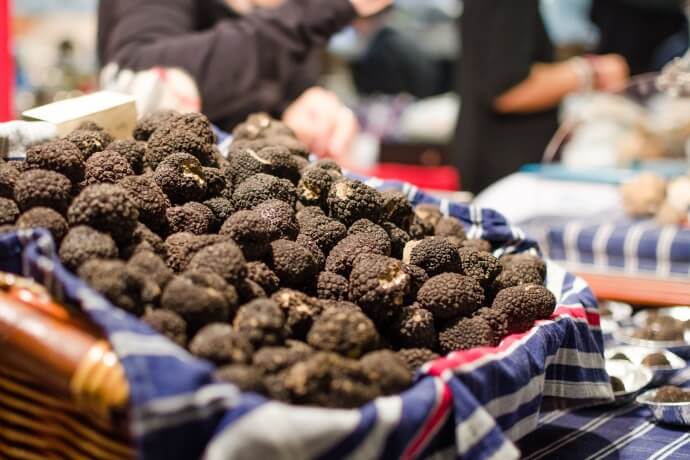
Truffles are a highly esteemed culinary delicacy found in the Piedmont region of Italy, which is particularly famous for its white truffles, regarded as some of the best in the world. We already know that this delicacy is as delicious as it can be, but what are truffles exactly? Truffles are subterranean fungi that grow underground in close association with tree roots. In Piedmont, truffles are found primarily in the Langhe, Roero, and Monferrato areas, where the soil and climate are ideal for their growth.
The truffle hunting season in Piedmont typically runs from September to December, and the region is a hub of activity during this time. Truffle hunters, or "trifulau", and their trained dogs roam the hills and forests in search of the elusive delicacy. The white truffle is particularly rare and expensive, and its value can reach thousands of euros per kilogram! Some of the best places to go truffle hunting in Piedmont include the Langhe and Roero areas, which are known for their black and white truffles. One popular destination for truffle hunting is the town of Alba, which is located in the heart of the Langhe region. Alba hosts an annual truffle festival called the "Fiera del Tartufo" where you can sample different truffle varieties and watch truffle hunting demonstrations. Alba's historic center features charming cobblestone streets, elegant piazzas, and a stunning cathedral, while the surrounding countryside is dotted with vineyards, hazelnut orchards, and truffle forests. Other towns and areas in Piedmont where you can go truffle hunting include the towns of Asti and Moncalvo, as well as the hilltop village of Barolo, which is famous for its wine as well as its truffles.
Truffles are a fundamental part of Piedmontese cuisine, and they are used in a variety of dishes, from simple pasta to elaborate meat and fish preparations. Some of the most popular dishes include tajarin (thin egg noodles) with truffle butter, risotto with truffles, and fonduta (a rich cheese fondue) with shaved truffles on top.
In addition to its culinary importance and purpose, truffle hunting is a significant cultural tradition in Piedmont, and many local festivals and events celebrate the truffle and the people who hunt them. Overall, truffles are an essential part of the rich gastronomic heritage of Piedmont, and they continue to be a sought-after delicacy for food lovers around the world!
Did you know that truffles are so prized and expensive that there have been instances of truffle theft by sneaky truffle bandits? That's right, these elusive fungi are so valuable that people will go to great lengths to get their hands on them. In fact, some truffle hunters keep their favorite truffle patches a closely guarded secret!
Cheeses
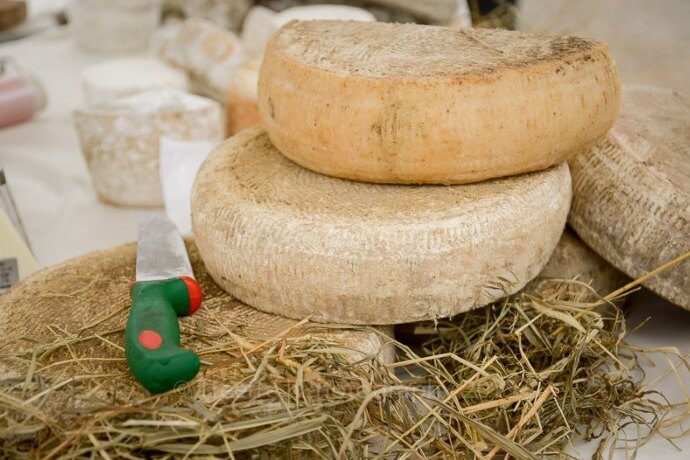
If you're a cheese lover, then Piedmont is the place to be! The region is a veritable cheese paradise, boasting an incredible array of mouthwatering cheeses that are steeped in history and tradition. These cheeses are made using time-honored techniques that have been perfected over centuries and are crafted with the utmost care and attention by skilled artisans. If you're a fan of tangy blue cheeses, creamy goat cheeses, or nutty aged cheeses, Piedmont might as well be your little piece of heaven!
One of the most famous Piedmontese cheeses is Castelmagno, a semi-hard cheese made from cow's milk that has been aged for at least three months. Castelmagno has a distinct flavor that is both sharp and tangy, with a slightly crumbly texture. Another popular cheese from the region is Robiola, a soft-ripened cheese that is made from a combination of cow's, sheep's, and/or goat's milk. Robiola has a creamy texture and a mild, slightly tangy flavor that pairs well with fruits, nuts, and honey, for example. Gorgonzola is another famous cheese from Piedmont, which is a blue cheese made from cow's milk. It is aged for several months, during which time it develops a tangy, pungent flavor and a crumbly texture. It is often used in sauces, spreads, and as a topping for salads and pizzas. If a strong-flavored cheese is your cup of tea, then this might be the right choice for you!
Other notable Piedmontese cheeses include Toma, a semi-hard cheese made from cow's milk that has a nutty flavor and a creamy texture; Bra, a semi-soft cheese made from cow's milk that has a mild, buttery flavor; and Murazzano, a soft-ripened cheese made from goat's milk that has a tangy flavor and a creamy texture.
Piedmontese meats
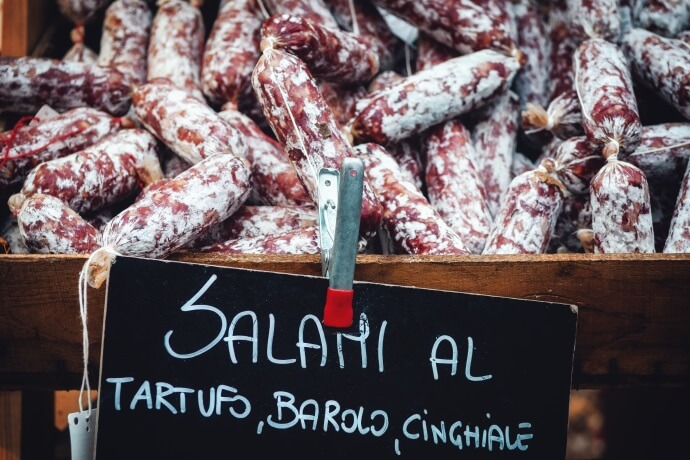
Piedmontese meats are a unique and important aspect of the culinary tradition of the Piedmont region of Italy. There are several factors that make these meats so special and highly regarded. Firstly, the animals used for Piedmontese meats are often from specific breeds that are known for producing high-quality meat. For example, the Fassona cow is used for beef dishes because it is known for producing meat that is particularly tender and flavorful! This Piedmontese beef is considered to be one of the most esteemed meats in Italy. Compared to other breeds, this meat is known for being leaner. As a result, it is often used in traditional Piedmontese dishes such as carpaccio-like carne crudo all'Albese, the classic vitello tonnato (veal with tuna sauce), and the mixed boiled meat dish known as bollito misto. These regional preparations are particularly enhanced by the high-quality meat of the Piedmontese breed.
In addition to the breed of animal, traditional production methods are also an important part of what makes Piedmontese meats so special. Many of the techniques used to produce these meats have been passed down through generations, ensuring that they retain their unique flavors and characteristics.
Another important aspect of Piedmontese meats is the diversity of products available. From raw beef dishes like carne cruda to mixed meat stews like bollito misto, there is a wide range of different meats and preparations to choose from. This diversity reflects the rich culinary tradition of the Piedmont region and the creativity of the chefs and producers who work with these products.
Finally, the popularity of Piedmontese meats extends far beyond the region itself. These products are highly regarded around the world for their quality, flavor, and versatility in the kitchen. Whether enjoyed in a local trattoria or served in a Michelin-starred restaurant, Piedmontese meats are an important part of the Italian culinary landscape and a true delicacy for meat lovers everywhere!
And let us keep in mind that Piedmont is known for its wide variety of cured meats as well, including salami, prosciutto, and bresaola. These meats are typically made with locally-sourced ingredients and aged for several months to develop their unique flavor.
Hazelnuts and Grissini
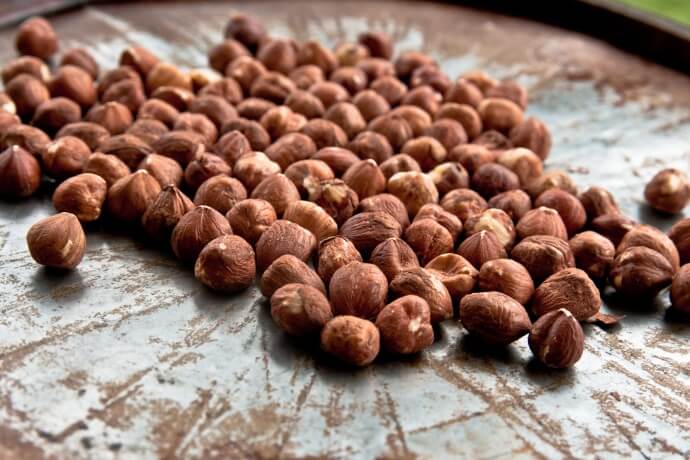
Move over peanuts, because the hazelnuts of Piedmont are the new stars of the nut world! These scrumptious little morsels are grown exclusively in the Piedmont region of Italy, where they thrive thanks to the area's perfect growing conditions. With a mild climate and nutrient-rich soil, it's easy to understand why Piedmontese hazelnuts have become a must-have ingredient for chefs and foodies around the globe. These nuts are prized for their unique flavor, which is nutty, sweet, and oh-so-delicious! The next time you're snacking on a handful of these tasty treats, remember that you're indulging in some of the best hazelnuts that money can buy!
Piedmontese hazelnuts are often referred to as "Tonda Gentile" and are recognized for their round shape and sweet flavor. They are used in a variety of culinary applications, from baked goods like cakes and cookies to savory dishes like sauces and meat preparations.
One of the most famous uses of Piedmontese hazelnuts is in the production of gianduja, a chocolate-hazelnut spread that originated in the region. The nuts are also used in the production of Nutella, a popular hazelnut-chocolate spread that is enjoyed around the world.
The high quality and unique flavor of Piedmontese hazelnuts have made them a highly sought-after ingredient in the culinary world. They are exported around the globe and are considered an important part of the culinary heritage of the Piedmont region!
However, if you're looking for a crispy snack with a little bit of history, look no further than grissini! These addictive breadsticks are a Piedmontese invention and have been a beloved snack for centuries. Made with just a handful of simple ingredients, including flour, water, yeast, and salt, grissini are a testament to the power of simplicity. And with their long, thin shape, they're the perfect vessel for dipping into your favorite sauces and spreads. Whether you prefer your grissini plain or loaded with herbs and cheese, one thing's for sure - once you start snacking on these crispy delights, it's hard to stop!
These breadsticks are a popular appetizer or snack in Piedmont and throughout Italy. They are often served alongside antipasti or used as a utensil to scoop up dips or spreads. In some cases, they may also be served with soup or salad. Grissini are now enjoyed around the world, and have become a staple in Italian restaurants and households. They are often packaged for convenience and sold in grocery stores or specialty food shops. It has become a beloved food item across the globe!
Barolo wine
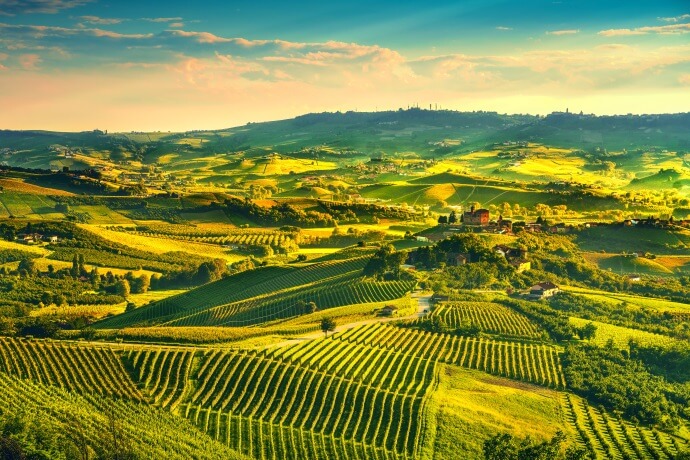
If you're looking for a wine that's as bold and confident as you are, the Barolo wine must be your first choice! This world-renowned red wine is the crown jewel of the Piedmont region, made exclusively from the Nebbiolo grape variety. With its complex aromas, robust tannins, and full-bodied flavor, Barolo is a wine that commands attention. And with a long and storied history dating back to the 19th century, it's clear that Barolo is a wine that has stood the test of time.
To be labeled as Barolo, the wine must be aged for a minimum of three years, with at least two of those years spent in oak barrels. The aging process gives Barolo its distinctive flavor profile, which is characterized by notes of cherry, leather, tobacco, and earth.
Barolo is often referred to as the "King of Wines" due to its high status and exceptional quality! The wine pairs well with hearty, flavorful dishes such as red meat, game, and aged cheeses (which is the perfect combination once in Piedmont!). In addition to Barolo, the Piedmont region is also known for other excellent red wines, including Barbaresco, Dolcetto, and Barbera.
Barolo wine has also played a significant role in the economy and culture of the Piedmont region. Many winemakers in the area have been producing Barolo for generations, and the wine has become an integral part of the region's cultural heritage. Wineries and vineyards in the Barolo wine region are also popular tourist attractions, attracting visitors from around the world who come to taste and learn about this exceptional wine.
So go ahead, pour yourself a glass of this rich and flavorful wine, and toast to your impeccable taste!
Asti Spumante

Asti Spumante is the sparkling wine that always knows how to put the "fun" in "functional." This sweet and bubbly beverage is produced in the Asti region of Piedmont, using the Moscato grape, which is known for its fruity and floral flavor.
The wine-making process involves fermenting the wine in stainless steel tanks with added yeast and sugar using the Charmat method, resulting in a wine with a light, bubbly texture, and a sweet taste. It's easy to understand why Asti Spumante is a popular choice for a light and refreshing aperitif or dessert wine!
Asti Spumante is often served chilled and paired with fruity desserts like fresh berries, tarts, or sorbets, making it a perfect summer drink. However, its versatility extends far beyond dessert pairing. This wine is also used as a mixer in cocktails or spritzes, making it a go-to drink for many occasions.
Whether you're celebrating a special occasion or simply looking to unwind after a long day, Asti Spumante is the perfect drink to lift your spirits and leave you feeling light and bubbly!
Panna Cotta

Panna cotta is a creamy dessert that originated in Piedmont, and its name literally means "cooked cream" in Italian. It is made by simmering together cream, sugar, and gelatin.
The mixture is then poured into individual molds and chilled until set. The result is a silky-smooth dessert with a delicate texture that is often served with fresh fruit or a fruit sauce.
While the traditional recipe calls for just cream, sugar, and gelatin, there are many variations of panna cotta that incorporate different flavors and ingredients. For example, some recipes may use milk or yogurt instead of cream, while others may add vanilla, chocolate, or coffee to the mixture.
Panna cotta is a simple yet elegant dessert that is perfect for special occasions or as a sweet treat after a meal. It is also a versatile dessert that can be adapted to suit a variety of dietary restrictions or preferences, such as using plant-based cream or sweeteners!
Panna cotta is a beloved part of Piedmontese cuisine and has become a popular dessert around the world. If life is uncertain, one thing you can always count on is the velvety smoothness and decadent deliciousness of a good panna cotta!



